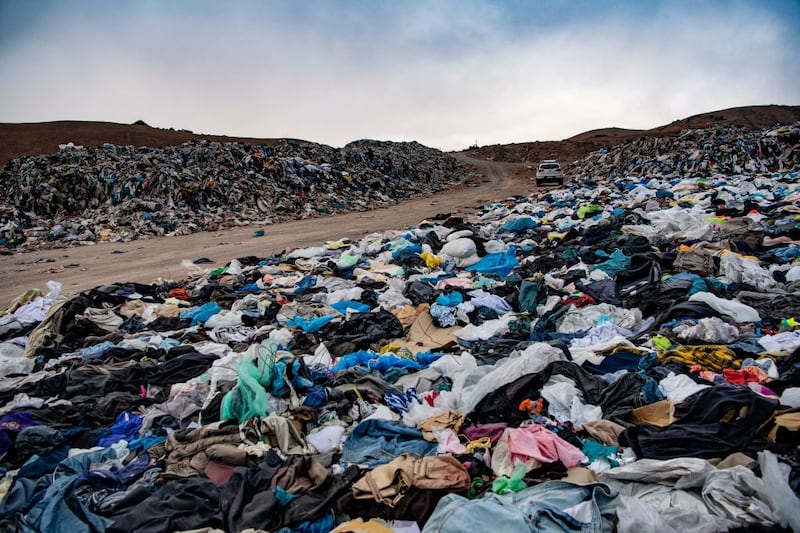These are dark days for Ireland’s “wardrobers”, “bracketers” and serial returners as the curtain falls on the golden age of free returns for all those online purchases that didn’t fit, cost more than the wine-soaked sofa shopping experience suggested or – for the very cheeky - were used as a one night (or day) stand before being sent back from whence they came.
While online kingpin Asos and others still have free returns – something Asos has said remains a “core part of our offer” – others have been making big changes since the start of the year.
Although fast fashion retailers such as Zara, Next and Boohoo have been shedding tears over the impact the deluge of free returns is having on their bottom line and facing criticism for looking at ways to shore up their defences by charging customers for processing the items they send back, the end of free returns is probably inevitable and – arguably – something to be welcomed.
Certainly the planet will be glad of any change coming down the tracks with wardrobing (returning clothes that have actually been worn) and bracketing (the buying of multiple sizes of the same item and returning all the ones that don’t fit) putting huge, and unnecessary, pressure on our limited natural resources up and down the supply chain.
READ MORE

It is not hard to see why the returning fashion crisis has reached a tipping point. Retailers are struggling in the face of a global cost-of-living crisis as delivery proves particularly sensitive to price hikes. Transportation, labour and processing costs have gone through the roof in recent months and retailers are looking for ways to make savings.
Curtailing returns offers huge savings. Globally, the cost runs to many billions of euro each year and eats into retailers’ already slim profit margins to a huge degree.
This summer, as it introduced a returns charge of €2.50 for shoppers in Ireland, Boohoo admitted things were looking bleak with a fall in pretax profits of 94 per cent despite an increase in sales of 14 per cent.
Zara also introduced a charge for online returns but – rather than focusing on its bottom line – it focused on the impact returns are having on the planet as a whole.
Both the environmental and economic narratives are true.
[ Fashion brands’ profits hit as customers return worn clothingOpens in new window ]
Mind you, while the impact returns have on retailers is profound, sometimes they only have themselves and their loose sizing to blame. One of the reasons returns are such a large part of the online shopping experience is that sizing – particularly for women – has long been all over the shop with numbers like 10, 12 and 16 meaning virtually nothing when it comes to the actual size of a garment. The reason for that is both historical and geographical.
Clothes sizes only became a feature of fashion in the 1920s after mass-production meant off-the-peg clothes became the norm. To standardise sizes, the US government started studying women’s body shapes in the late 1930s but it was more than 20 years before a commercial standard, combining measures for bust, height and hip, emerged. By then, body shapes had changed so sizing became pretty meaningless. To make things worse, sizes in different parts of the world differ, so a US six is an Irish 10, a French 36 and a Japanese nine.
Then there is also vanity sizing, which sees retailers and clothes-makers cut their sizes more generously to make shoppers feel better about themselves and more inclined to buy. Sloppy manufacturing doesn’t help matters and the consequences of this sizing free for all are real when it comes to online shopping.
It is the planet which pays the ultimate price.
A huge percentage of returned items never go back on sale, use huge volumes of natural resources and generate masses of pollutants only to end up in landfill. In the US alone more than 2.5 million tonnes of returns found its way to landfill in 2020 because the cost of readying the clothes for the racks was simply too expensive.
So expensive, in fact, that American retailer Walmart has even told shoppers on occasion to hang on to the clothes they have got refunds for.

According to TU Dublin retail expert Damian O’Reilly, “all that might be needed is for the product to be ironed but the cost of putting it back on the shelves is deemed to be too prohibitive”.
“While we may see returns as free, the cost to the retailers is around 20 per cent of the order value and that puts a lot of pressure on profit margins.”
O’Reilly says many people remain unaware of the consequences of free returns. “I don’t think many people know that the clothes they are returning are going to landfill and sometimes they are to blame by returning clothes that are scrunched up and wrinkled or worn for a day and as a result not salvageable.”
A recent study from KPMG entitled Next Gen Retail found – unsurprisingly – that younger customers in Ireland are far more likely to shop online, with 43 per cent of 18–24-year-olds buying clothes more online, compared to 26 per cent of the general population.
It also identified a conflict. While about one-third of consumers said a retailer’s support of good causes or sale of sustainably sourced or produced products made them more likely to shop with that retailer, rising to half among the 18-24-year-olds, most people reject the notion that they might have to pay more for excess packaging and environmental improvements.
“So, the challenge will be for retailers to either convince customers it’s worth paying for or do it in a way that does not significantly increase prices,” the report says.
O’Reilly wonders if the problem is not pricing but a business model that is reliant on eternal growth and says that “if online retailers are not growing their customer base year-on-year they are in a very difficult place”.
He notes that online retail exploded during the pandemic as shops were either closed or people were reluctant to go into them, preferring to buy from the safety and comfort of their own homes. Our love of loose fitting athleisure also made it easier for online retailers to sell to us. “That meant that there wasn’t so many items being sent back but now that people are out and about more, and more concerned about what is on-trend, returns have increased dramatically,” O’Reilly says.
He points to the ways different retailers have managed their messaging in recent months. “Zara have done it well, I think, and made it about the environment which has appealed to Gen Zers. They have also allowed people to bring returns back to physical stores. Boohoo, by contrast, has made it about their profit margins and said simply that ‘we are losing money and we need to address that’.”
There does appear to be a disconnect among consumers about the consequences of free returns. We asked Twitter users if they frequently bought knowing they would have to return some items and if charges for returns change their shopping habits.
“I buy loads and return loads,” responded Rose O’Connor Ryan. “Free post and free returns. Feel like I’m keeping An Post and DPD in business. Would be more considered if it cost more, but it doesn’t.”
Companies charging for returns impacted Anna Carey’s choices. “Most brands I buy from online don’t do free returns and it makes me way more careful about buying, to an annoying degree – there have been things I really love and am not sure will fit me but the return costs would push it out of my affordability range,” she posted.
“Return policy is the first thing I look at,” said Vickey Curtis. “I won’t use certain vendors if I’ve to pay return charges.”
Yvonne Cooney said returns were “part and parcel” of the online shopping experience because “you don’t see the items in hand”. She added that she would not shop with retailers who charge for returns.
One retailer who famously decided not to bother with free online returns – or indeed any online returns – is Penneys. “From the very start they were very keenly aware of the returns issue and because they are on very tight margins decided not to sell online but they will eventually go online,” explains O’Reilly.
He suggests the company will only do so when it knows how to make it work and how it can best manage all the returns that will come its way. It might be able to teach a thing or two to other retailers struggling to work out what the best approach is.













